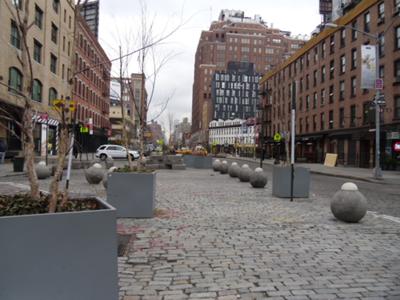Consider Street Closures to Allow Other Public Uses and Meet Multiple Objectives
Published: June 17, 2024
Recently we have seen a wave of street closures for the purpose of expanding outdoor dining, creating a new green space as a mini-oasis, or improving a plaza with some benches and other amenities. Obviously the Covid-19 pandemic both started and accelerated the trend, as cities became open to trying anything to encourage more walking, less transit use, and more outdoor dining as opposed to the often-impossible indoor dining. The unintended consequence was that many cities discovered that closing down some streets, in full or in part, was not only tolerable, but it was also downright pleasant.

One of my close planner friends lives in New York and jogs past several of these green streets. Street closures or partial closures have become common in Manhattan, as bus lanes, bicycle lanes, medians denoting truck loading zones, planting strips, every kind of plaza with or without seats, and even 45 degree parking are being approved by community councils. Sometimes the street closures (whether permanently vacated in the legal sense, or only temporarily closed) have been decorated with landscaping and a whole variety of street furniture.
Many of these are most attractive; now it's hard to imagine that once there were that many lanes of traffic. Sometimes transit vehicles are allowed to use the streets, but no other vehicles are permitted. Accommodation for deliveries may or may not be made, depending on whether most stores, offices, or residences have access to a rear alley.
Truthfully, I think that the partial street closures, which also can be thought of as road diets or skinny streets or complete streets, are a step in the right direction.
Many large cities have become too congested for pleasant driving. When transit is available freely and streets are walkable, other uses of former driving lanes are desirable.
Temporary and Experimental Street Closures to Create Green Space
Also in San Francisco there is a holiday allowing groups to turn parking spaces into parklets for a day, as a sort of what is being called a parklet. By now the parklet idea has become widespread; read more about that on the parklet page.
The parklet phenomenon certainly is a San Francisco tradition by now. I haven't heard of too many imitations, but occupying some parking spaces with something more interesting is a useful beautification idea.
Note that this technique can be done on a temporary basis and usually is. Pop-up parks can use potted plants destined for a charity fund-raiser the next day, and matched or mis-matched tables and chairs borrowed from homes and businesses.
Maybe for a one-day event someone will loan you a striking piece of sculpture or part of a tree they have just cut down as a sculpture.
Choose off-peak parking hours, of course, but in many places in cities, the parking lanes or even meters rarely are used.
Visually interesting green spaces, public gathering or performance areas, and public art all make sense when streets and roads are too wide.
Plazas without shade and seating make less sense, but then again, certainly the photo here is more stimulating than a wider expanse of asphalt.
Be aware of potential backlash if you misjudge the potential of the narrowed street to handle traffic. However, in most cases, cars have more than enough room, don't you think?
- Making and Keeping a Good Community ›
- Community Improvement Projects › Street Closures
Join GOOD COMMUNITY PLUS, which provides you monthly with short features or tips about timely topics for neighborhoods, towns and cities, community organizations, and rural or small town environments. Unsubscribe any time. Give it a try.
